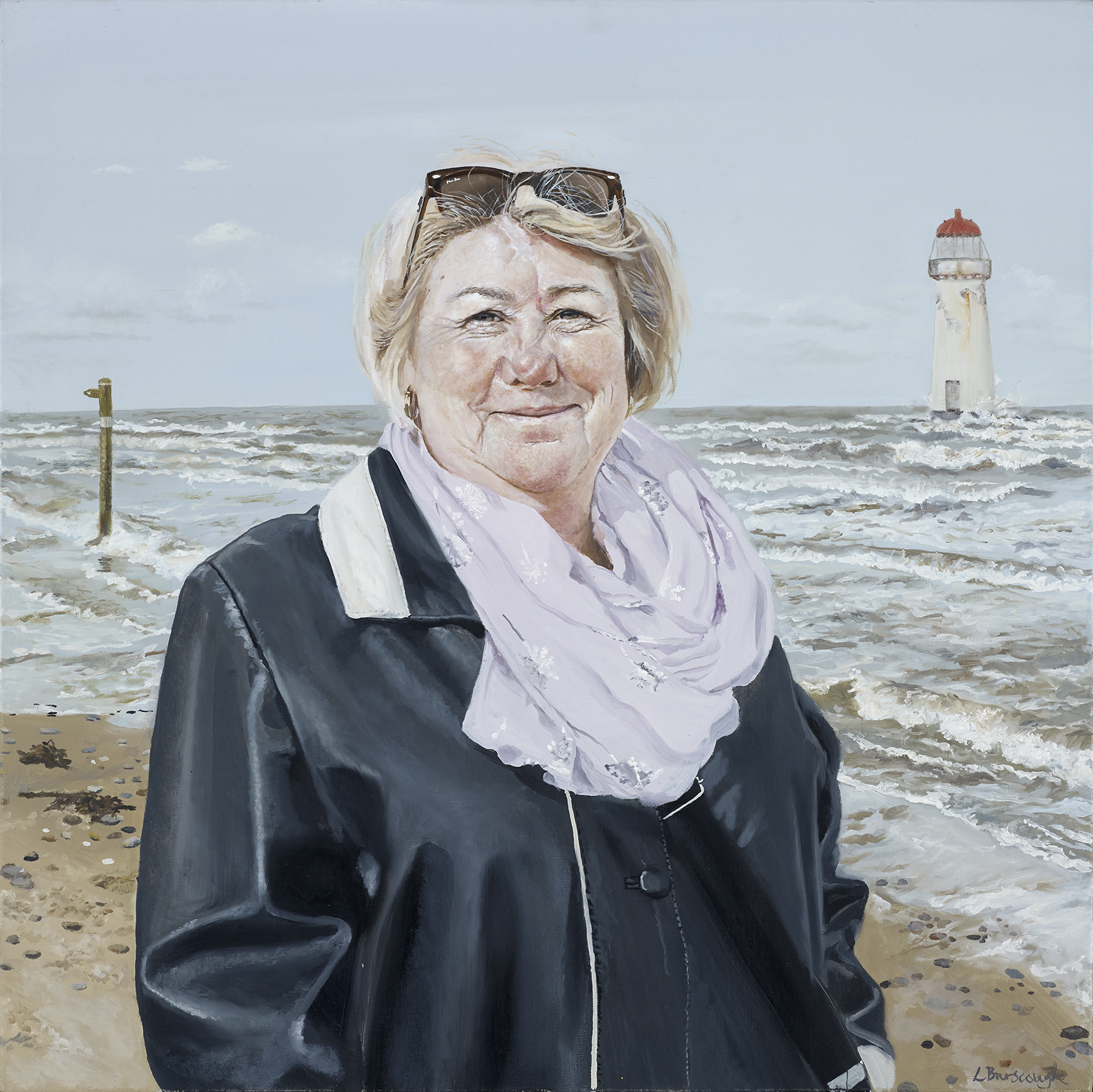
'Trudi', 2018. Oil on canvas.
After several meetings and in-depth conversations, it was decided that the portrait should acknowledge Trudi’s cancer journey and the transformative experience at the Christie art group by featuring a lighthouse. Trudi had a long relationship with North Wales and its coast as she had holidayed there regularly as a child and continued to do so. Talacre beach was visited for the photoshoot. The journey allowed the artist and subject the opportunity to cement a firm relationship. Talacre was a great choice as the lighthouse there is easily identified and many of the people who watched the work in progress at Maggie’s knew the resort well and were pleased to recognise it as they met the artist and heard about Trudi’s story.
While painting Trudi’s portrait, as happened with all the paintings, viewers would speculate about the personality of the subject. Many people would say, ‘She looks like she’s a strong woman’, and indeed she is. One thing that was also regularly commented on was Trudi’s ‘English rose’ or ‘strawberries and cream’ complexion. Trudi was delighted by these comments, particularly as she was so unhappy about her scarring. She would often repeat them to friends and family who came to see the progress of the painting saying, “It’s all natural! No make-up!”. The genuine joy and pride that she radiated at these times, in contrast to the woman who had first come to Maggie’s hiding her face under a hood, in the view of the artist, made the project worthwhile and hugely substantiated the assertion that portraiture can be a powerful tool in arts for health practice.
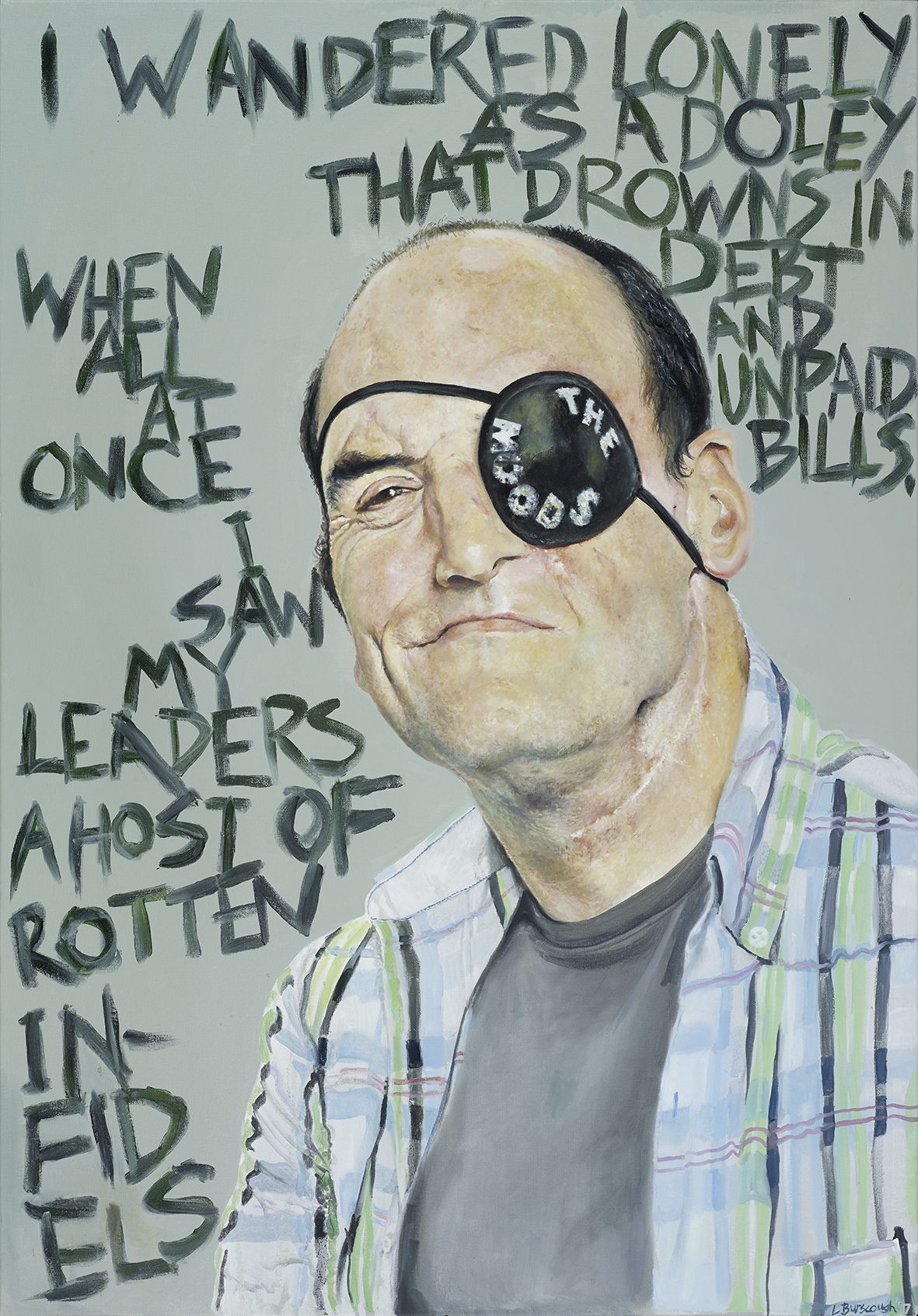
'Bern', 2017. Oil on canvas.
Lucy painted Bern in late summer and autumn of 2017. A large series of photographs were taken by the artist with a studio set-up, in her studio at Lime Arts, in the grounds of Central Manchester NHS Trust. Bern and Lucy had been ‘virtual’ friends online for more than two years so was aware of how much his support of socialist politics played a part in his interaction with the world. Bern often wrote poetry to share his humour, thoughts and experiences, in conversation with the artist, it was decided that lines from one of his poems would help to share Bern’s wider identity with the world. He also decided that he would wear a specially commissioned eye-patch promoting his favourite Mancunian band, The Moods. The image that would be worked-up to produce the portrait was decided upon in discussion with Bern and some of his siblings. Lucy will often call upon family members or friends of subjects she hasn’t spent much time with to help narrow down which image best captures their personality. The image that was decided upon was chosen because it captured Bern’s affable personality and the dignity that he maintains despite the physical degradation that he has had to endure.
Bern and his family visited Maggie’s regularly during the painting of his portrait. They were hugely excited by their involvement with the project, documenting the experience with numerous of photos which they promoted widely on social media. Over the duration of the project the artist has developed relationships with all of Bern’s siblings and is convinced that their practical and emotional support has been invaluable in maintaining Bern’s mental health. They have been hugely involved in the project, from the initial photo-shoot, through to curating the exhibition, celebrating its opening, and attending numerous engagement events.
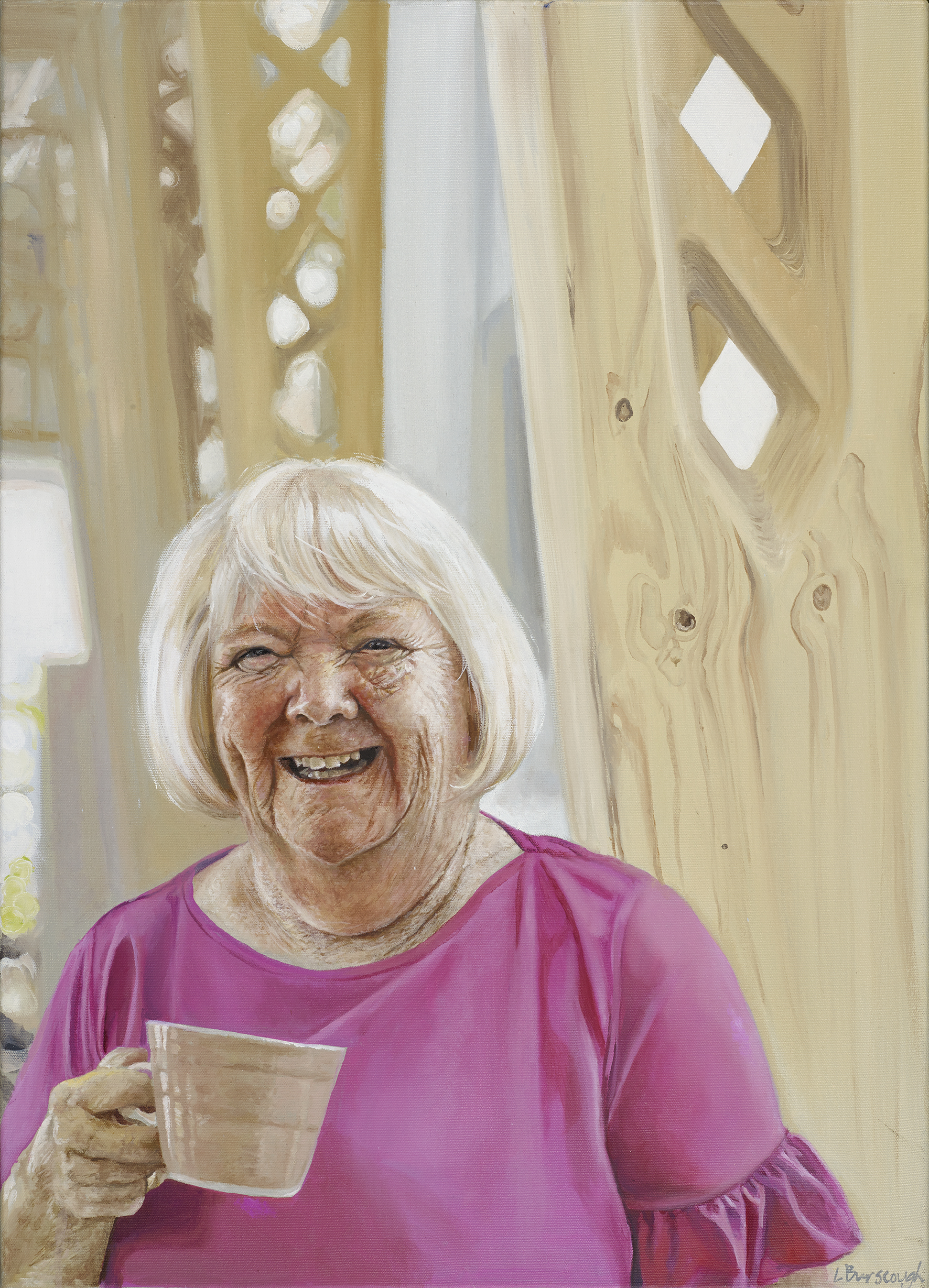
'Annie', 2017. Oil on canvas.
Following several informal conversations and the recording of a long ‘getting to know you’ audio interview, Annie decided that she would like the portrait to reflect her core values which centred around social responsibility and giving back to the community. This would be illustrated by locating the portrait in the Maggie’s Centre itself, with its unique wooden structure visible and recognisable, and Annie would be pictured holding a cup of tea in one of the centre’s hand thrown cups. This element would serve to illustrate the ‘tea and sympathy’ or ‘tea and a giggle’ that is offered by Annie and the team of volunteers to all of Maggie’s visitors. The artist was particularly happy with Annie’s involvement with the project and the choice of this setting for the portrait. It allowed the subsequent exhibition to talk about and celebrate the invaluable support offered by Maggie’s and raise awareness amongst exhibition audiences of what this relatively little-known charity offers.
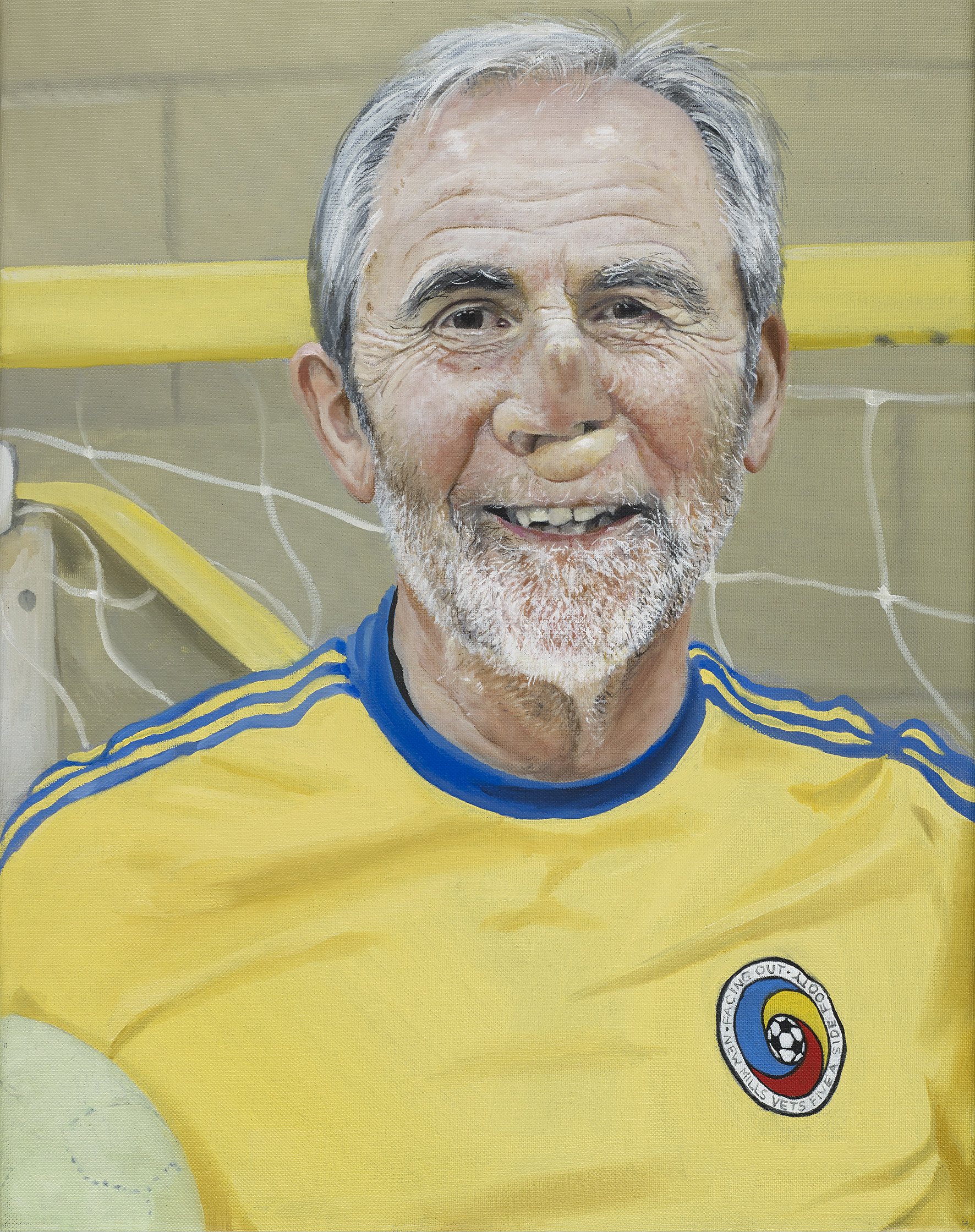
'Nigel', 2018. Oil on canvas.
The artist met Nigel when he attended the second day of the Manchester Science Festival 2017 Facing Out Conference at The Whitworth (See blog). The event had been advertised at The Christie’s Head and Neck clinic and Nigel had picked up a flyer and come along. He already had an interest in how creative activities can bring people together and have positive benefits to health and well-being as he worked as arts development lead at his local Community Volunteer Support service. His job had seen him develop very successful community festivals and creative groups. He was very impressed by the conference and was interested in the wider project and perhaps becoming a portraiture subject.
After the conference, Nigel came to Maggie’s with his wife to talk about what becoming a portraiture subject would entail. From Lucy’s point of view it was interesting to talk to Nigel about the project as he asked questions with a facilitator’s insight. He agreed to go ahead and suggested that his portrait should depict his long-running membership of a local veterans five-a-side football team that he had been a member of for twenty-five years. When Nigel was receiving cancer treatment, he had had to step back from the team so, when he managed to make his comeback, it was a significant marker on his road to recovery. Nigel’s love of football and having an active lifestyle played another significant role in his cancer experience. It was because of wanting to be able to continue to play football and swim unimpeded that Nigel chose not to have a magnetically attached prosthetic nose, but to go for reconstruction. Nigel’s reconstruction involved the use of a free flap that was harvested from his lower arm to reconstruct an area around his upper lip and cartilage for his nasal bone that was taken from his ribs. Although the site of the cancer was successful covered, unfortunately, radiotherapy caused the nasal reconstruction to collapse down and so Nigel’s nose was left sloping inwards.
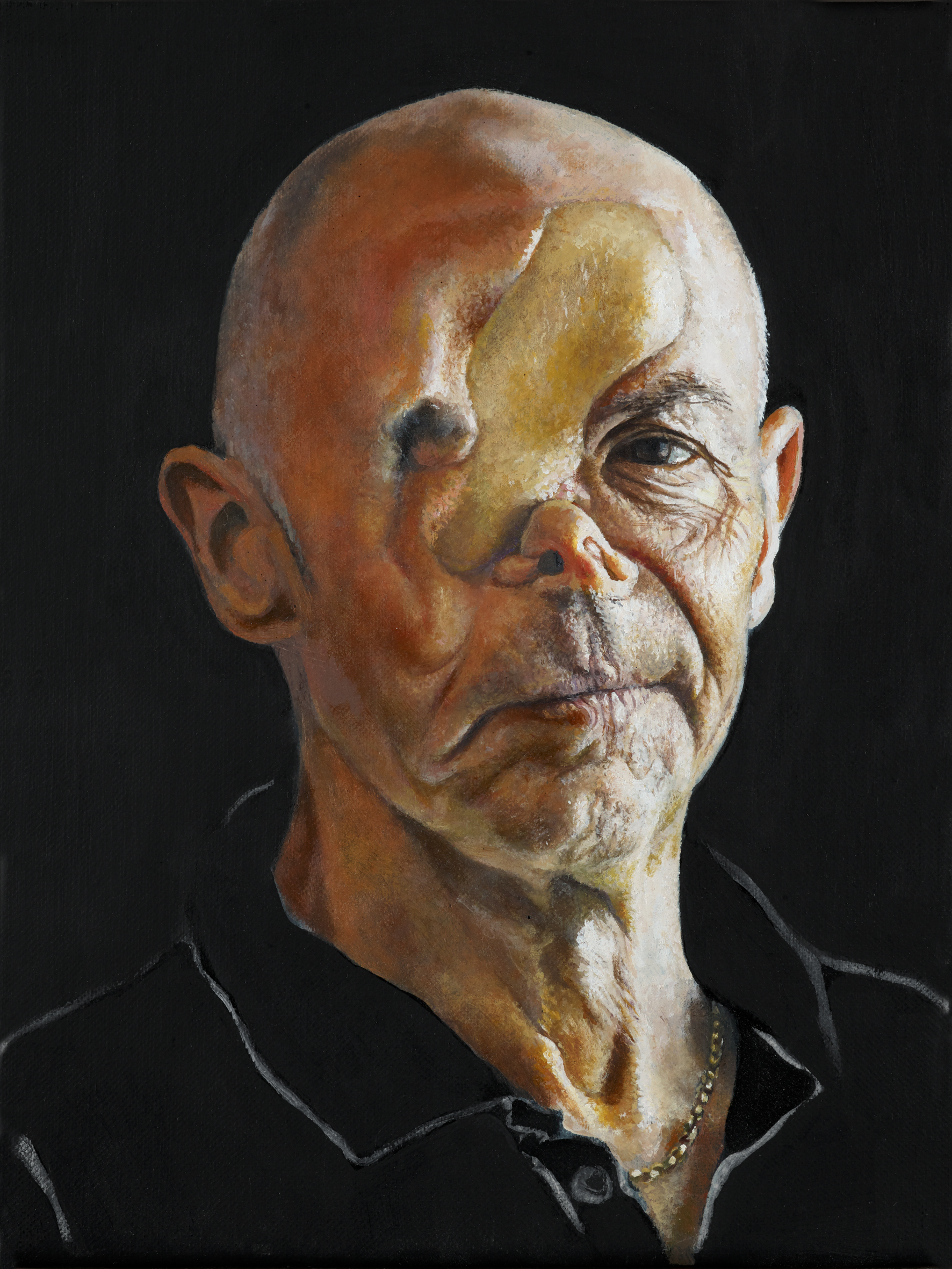
'Graeme I', 2018. Oil on linen.
This portrait shows Graeme as he looked when Lucy first met him. His right eye has been removed, as has a large amount of the surrounding bone and tissue, including sections of the nose, right cheek and forehead. The flap covering this area was taken from a donor site on his thigh. Graeme also had nerve damage to the right side of his face which affected the movement of his month (specifically smiling) to some extent. You can see a marked depression in his forehead and significant reduction in the length of the nose, such that the bottom of the nose was parallel with the cheeks. This meant that functionality for breathing was impaired and, less obviously a problem, he wasn’t able to wear glasses.
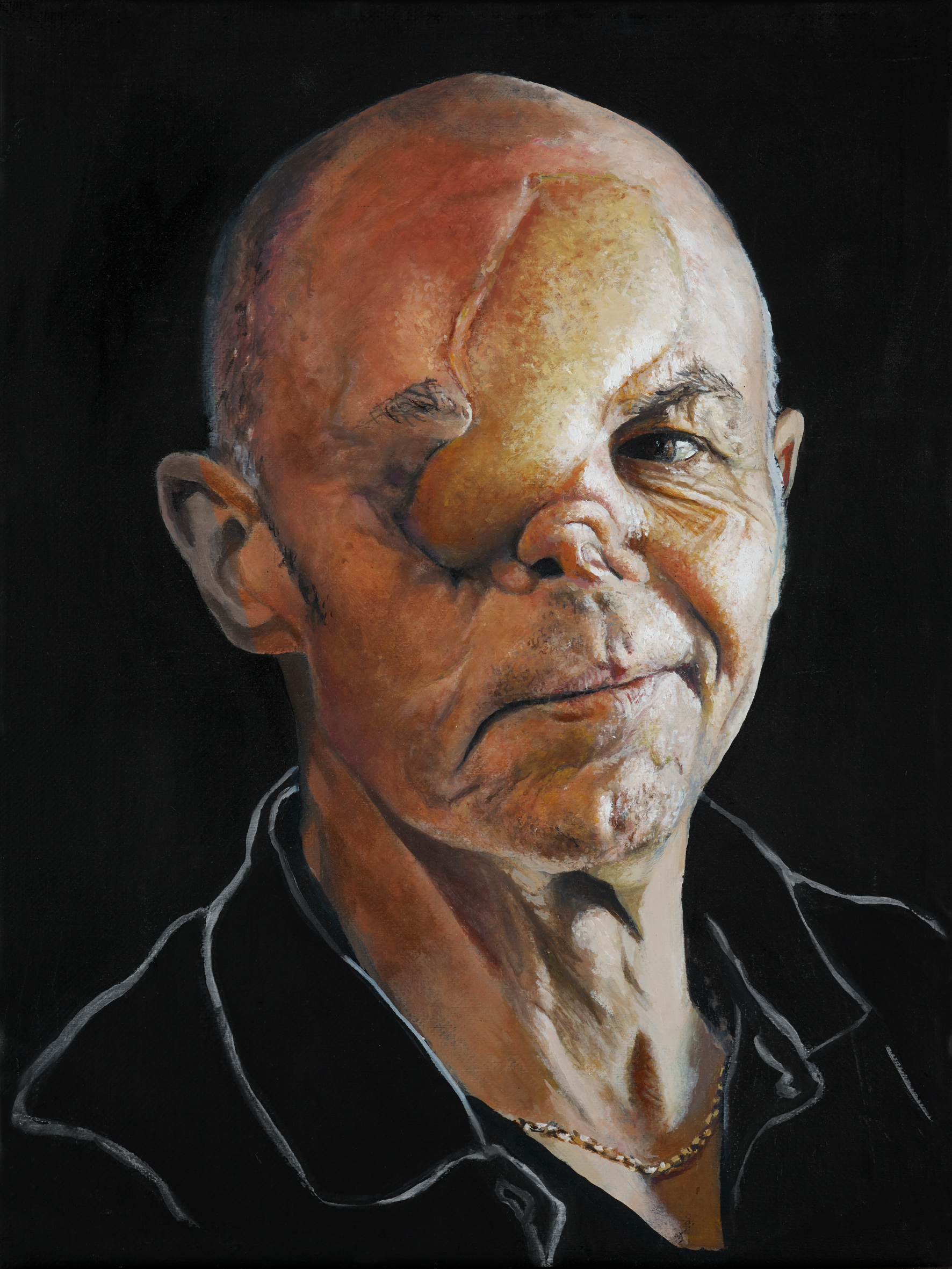
'Graeme II', 2018. Oil on linen.
Prior to this portrait, Graeme had decided to go ahead and follow his surgeon’s advice and have further reconstructive surgery. A titanium plate was used to cover the area of bone loss in his forehead and some local flaps were drawn from the cheeks to bring the nose further forward and ease breathing. As perhaps his expression shows, at this point, Graeme was very pleased with the surgery. Unfortunately, between portraits II and III, the surgery began to cause problems and Graeme was rushed into hospital to have emergency surgery. The previous operation had caused tissue fluid to gather around the implant which meant that surrounding tissue became no longer viable. The emergency operation drew some of Graeme’s scalp forward to replace the damaged area and try and save the functioning forehead flap and new nasal flaps.
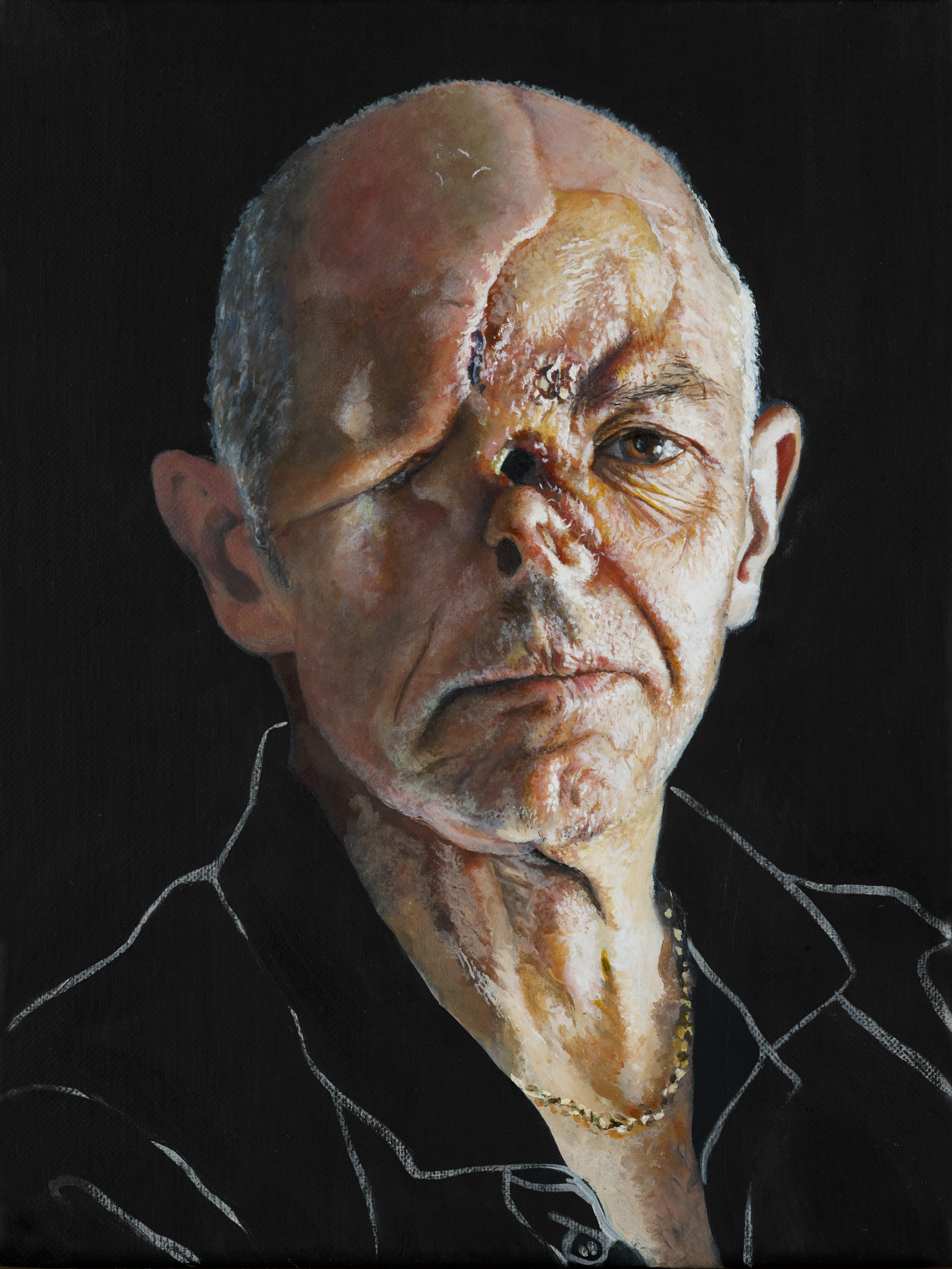
'Graeme III', 2018. Oil on linen.
As the time of photographing for this portrait, Graeme was dismayed and indignant at the turn of events that had led to the frightening position he was in now: areas of his face that had previously been stable, if lacking in some aspects of functionality, seemed to be breaking down. There were areas on the nose and forehead that were becoming holes, and the remaining forehead flap appeared to be thinning as if its previously health blood supply was constricted. The artist was shocked by Graeme’s worsening appearance and worried about whether his seemingly inexhaustible levels of resilience would, this time, run dry. He was equally angry with his surgeon and with himself for going ahead with this ill-fated surgery. He looked back at the first portrait and wished he hadn’t embarked on the surgery.
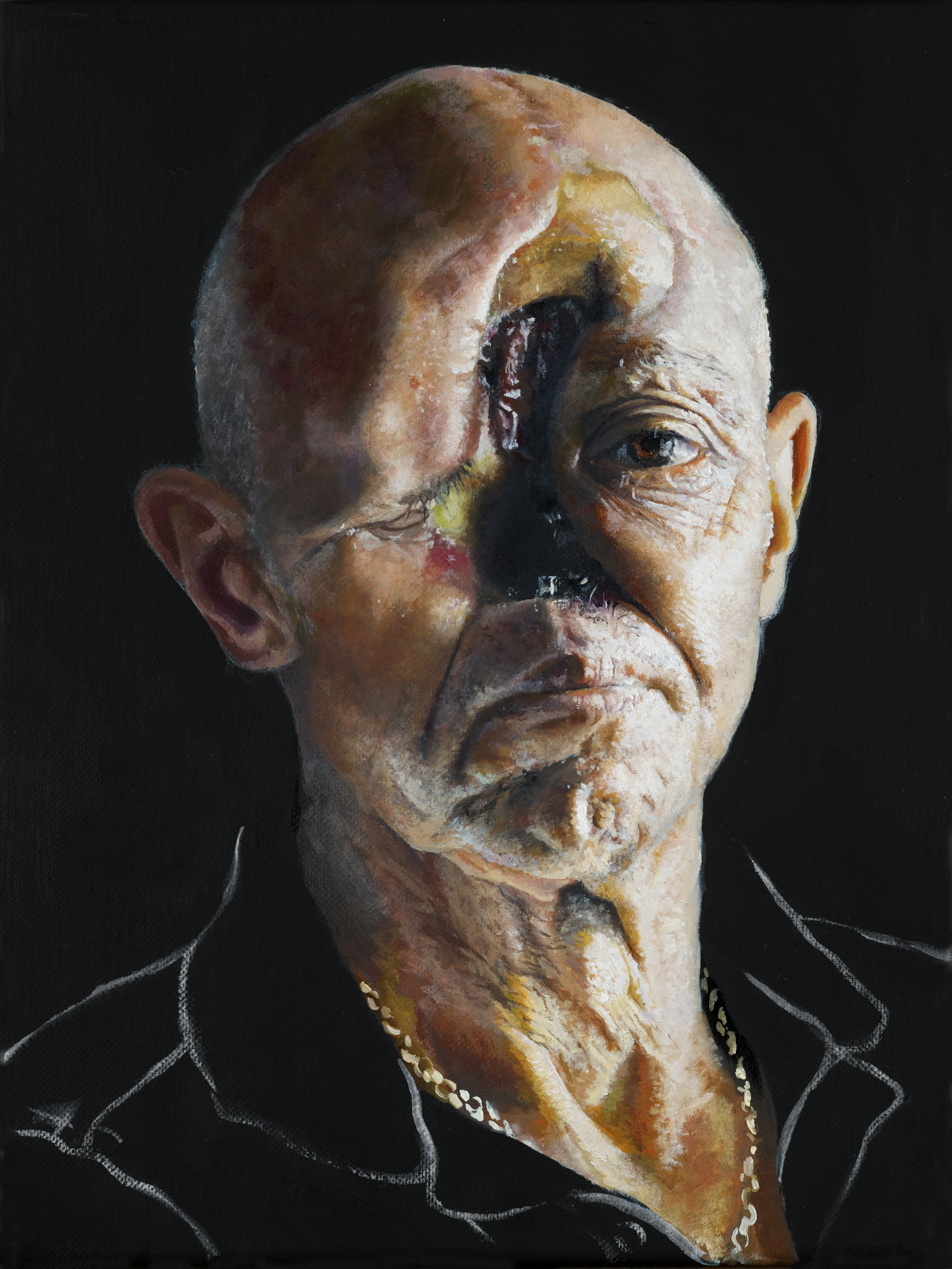
'Graeme IV', 2018. Oil on linen.
When the photographs for this portrait were taken, the titanium plate across Graeme’s forehead had been removed, as had his nose and the lower half of the original flap from his thigh. It had been decided that the only way for Graeme to move forward was to have a prosthesis made to cover the lost areas, including his right eye. This portrait shows what Graeme had had covered with a dressing for three months. He hadn’t showed his face as it now was to anyone beyond his family and medical team up until this point. It is possible to see three magnets that were bedding in around his nasal aperture which would hold the prosthesis in place.
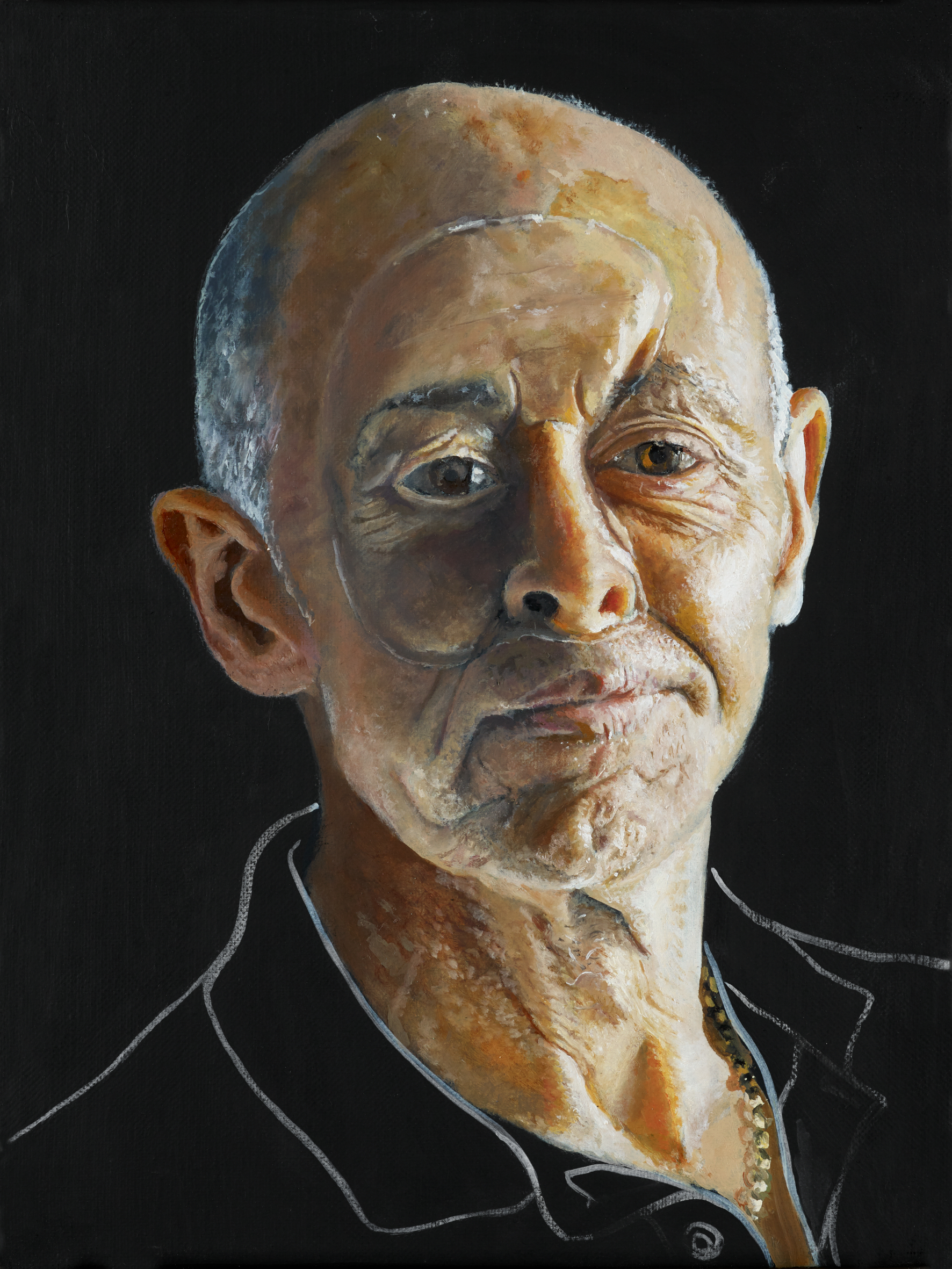
'Graeme V', 2018. Oil on linen.
Graeme’s final portrait shows him with his prosthesis in place. It was painted in the final days of the production phase. Graeme, for as long as the artist had known him had said that he had wanted to keep his nose, ‘It’s a strange nose, but it’s mine’. That wasn’t to happen but, when Graeme actually got his prothesis, he felt that it was a very positive change. That was certainly the case in relation to how he felt about how his appearance in the previous few months, but he also saw it as an improvement on his appearance in the first portrait. He was particularly happy that he could now walk down the street without drawing people’s attention and gaze.
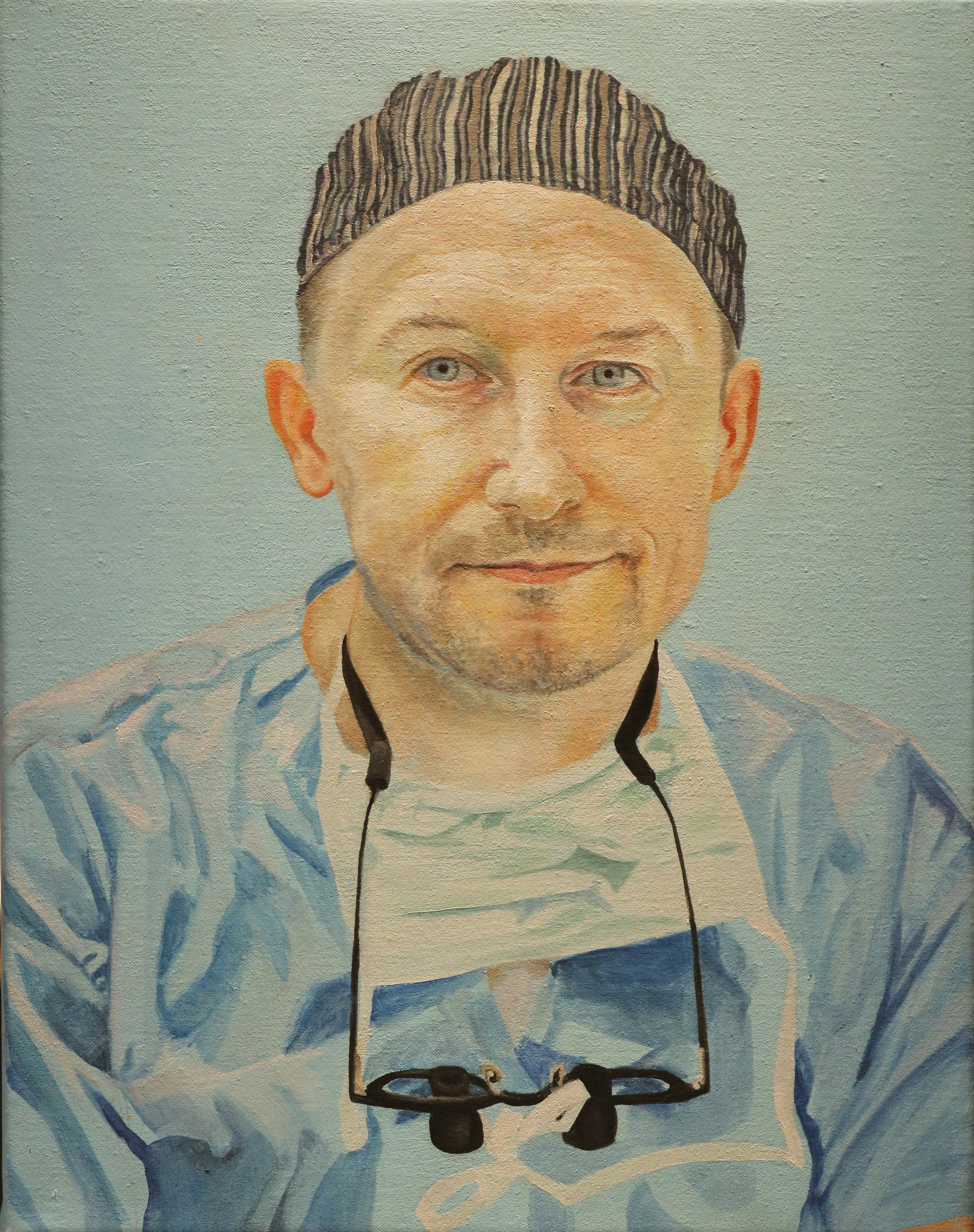
'Damir', 2019. Oil on canvas.
The photographs for the portrait were taken early in the morning at The Christie directly before Damir embarked on a day of surgery. Damir is wearing his surgical scrubs and loops, the magnifying spectacles that allow microsurgery to be undertaken. These loops were bought for Damir by his parents many years ago and so hold an emotive significance for him. He uses them in his day to day practise. This particular image was chosen because the artist felt that his expression spoke of Damir’s deep commitment to do his best work for his patients and the time, planning, effort and sacrifice that enables that to happen. Visitors to the Maggie’s Centre regularly commented about Damir’s portrait, ‘Doesn’t he look kind?’.
